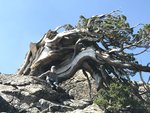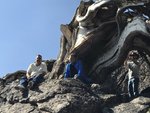Ok, let’s talk about this...
You mention “natural, grey look”. Yes, that’s what they do in YOUR environment, but that’s NOT how they appear in THEIR natural environment! You see, where they live in higher elevations, the air is much drier, the UV is much stronger, and the dead wood, while not “white” is much much brighter and “whiter” than what happens in lower elevations. So, the bleaching makes them actually appear more natural!
Here are some pictures of Sierra Junipers at 10,000 feet:
View attachment 330486
View attachment 330487
View attachment 330488
View attachment 330489
That deadwood looks “white” doesn’t it? Of course, when you get right up next to it, it’s not as white as it appears from a distance, but we are trying to emulate how it appears when standing back looking at the tree as a whole.
So, yes, that means you should beach out the deadwood. I’m like you, I don’t care for deadwood that appears “painted” with lime sulfur. Natural deadwood has texture with cracks and checks. A smooth, sanded, painted appearance of the deadwood looks too artificial. So, here’s what I do:
1) Wet and scrub the deadwood with water to remove surface algae and mildew. Paint the deadwood with white wine vinegar. That should kill the moss and algae. In about a week.
2) Treatment of the live vein(s) is a personal preference, but I tend to go with the smooth look rather than the “flaky” look. Here’s why: when you look at the trees from a distance, the bark appears rather smooth and cinnamon colored. Up close, they’re still rather smooth because they are subjected to high winds and heavy snows that break off the flakes. Flaky bark, on junipers, shows youth, not age. Remember, the old trees in the mountains are hundreds if not thousands of years old! So, I prefer removing the flaky bark and going with the smooth appearance, like you saw Bjorn doing.
3). Applying line sulfur: My technique is to first wet the deadwood well, and let it partially dry back out. Maybe wait an hour after I’ve wet it. Mix the lime sulfur 50/50 with water, and paint the deadwood. Doing it this way makes the lime sulfur soak into the deadwood, rather than lay on top. When first applied, it will be yellow, and it will turn white as it dries. If limesulfur is applied straight, with no dilution, it will appear more like a layer of paint, and be really white when it dries. Almost shiny. My method still shows the natural wood graining and it will be bleached but not stark white. It will have more of a matte finish.
Here are some examples of my trees treated in the manner I described:
View attachment 330490
View attachment 330491

















